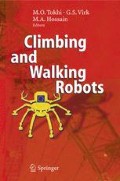Abstract
In this paper different robot applications are presented that are driven by flexible fluidic actuators. These pneumatically driven actuators are biologically inspired. The first robot presented is an eight legged walking machine with 48 compliant joints. Then an auto propulsive flexible endoscope will be presented, followed by a serpent and an elephant trunk.
Access this chapter
Tax calculation will be finalised at checkout
Purchases are for personal use only
Preview
Unable to display preview. Download preview PDF.
References
Maskrey RH, Thayer WJ (1978) A brief history of electrohydraulic servomechanisms. ASME J. Dynamic Systems Meas. Control, pp. 110–116.
Schulte H F Jr (1961) The characteristics of the McKibben artificial muscle. In: The Application of external power in prosthetics and orthotics. National Academy of Sciences-National Research Council, Washington D. C., Appendix H, pp. 94–115.
Inoue K (1988) Rubbertuators and applications for robots. Robotics Research: The 4th International Symposium, Bolles R, Roth B (eds). MIT Press, Cambridge, Mass. p.57–63, May 1988, Univ. of California, Santa Clara, California, United States.
Schulz, S.; Pylatiuk, C.; Bretthauer, G. (1999) A New Class of Flexible Fluidic Actuators and their Applications in Medical Engineering. Automatisierungstechnik, Vol. 47, No. 8, pp. 390–395.
Kato I. (1985) Development of Waseda Robots-The Study of Biomechanisms at Kato Laboratory, Tokyo, Waseda University publication dedicated to I. Kato 60th anniversary jubilee.
S. Schulz, C. Pylatiuk, G. Bretthauer: Walking Machine with compliant joints. 4th International Conference of Climbing and Walking Robots (CLAWAR 2001), 24th–26th September 2001, Karlsruhe, Germany.
Parry, D.A.; Brown, R.H.J. (1959) The hydraulic mechanism of the spider leg. J. Exp. Biol. 36, pp. 423–433.
Sens, J. (1996) Funktionelle Anatomie und Biomechanik der Laufbeine einer Vogelspinne. Master Thesis, (in German), University of Saarland, Saarbrücken, Germany.
Author information
Authors and Affiliations
Editor information
Editors and Affiliations
Rights and permissions
Copyright information
© 2006 Springer-Verlag Berlin Heidelberg
About this paper
Cite this paper
Schulz, S. et al. (2006). Fluidically Driven Robots with Biologically Inspired Actuators. In: Tokhi, M.O., Virk, G.S., Hossain, M.A. (eds) Climbing and Walking Robots. Springer, Berlin, Heidelberg. https://doi.org/10.1007/3-540-26415-9_11
Download citation
DOI: https://doi.org/10.1007/3-540-26415-9_11
Publisher Name: Springer, Berlin, Heidelberg
Print ISBN: 978-3-540-26413-2
Online ISBN: 978-3-540-26415-6
eBook Packages: EngineeringEngineering (R0)

